Advertisements
Advertisements
प्रश्न
ABCD is a trapezium with parallel sides AB = a cm and DC = b cm (Figure). E and F are the mid-points of the non-parallel sides. The ratio of ar (ABFE) and ar (EFCD) is ______.
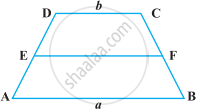
विकल्प
a : b
(3a + b) : (a + 3b)
(a + 3b) : (3a + b)
(2a + b) : (3a + b)
उत्तर
ABCD is a trapezium with parallel sides AB = a cm and DC = b cm (Figure). E and F are the mid-points of the non-parallel sides. The ratio of ar (ABFE) and ar (EFCD) is (3a + b) : (a + 3b).
Explanation:
Given, AB = a cm, DC = b cm and AB || DC.
Also, E and F are mid-points of AD and BC, respectively.
So, distance between CD, EF and AB, EF will be same say h.
Join BD which intersect EF at M.
Now, in ΔABD, E is the mid-point of AD and EM || AB
So, M is the mid-point of BD
And EM = `1/2`AB [By mid-point theorem] ...(i)
Similarly in ΔCBD, MF = `1/2`CD ...(ii)
On adding equations (i) and (ii), we get
EM + MF = `1/2` AB + `1/2` CD
⇒ EF = `1/2`(AB + CD) = `1/2`(a + b)
Now, area of trapezium ABFE
= `1/2`(sum of parallel sides) × (distance between parallel sides)
= `1/2(a + 1/2(a + b)) xx h`
= `1/4(3a + b)h`
Now, area of trapezium EFCD
= `1/2[b + 1/2(a + b)] xx h`
= `1/4(3b + a)h`
∴ Required ratio = `"Area of ABFE"/"Area of EFCD"`
= `(1/4(3a + b)h)/(1/4(3b + a)h)`
= `((3a + b))/((a + 3b))` or (3a + b) : (a + 3b)
APPEARS IN
संबंधित प्रश्न
In the given figure, ABCD is parallelogram, AE ⊥ DC and CF ⊥ AD. If AB = 16 cm, AE = 8 cm and CF = 10 cm, find AD.
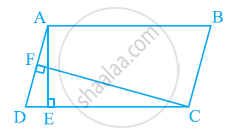
If E, F, G and H are respectively the mid-points of the sides of a parallelogram ABCD show that ar (EFGH) = 1/2ar (ABCD)
A farmer was having a field in the form of a parallelogram PQRS. She took any point A on RS and joined it to points P and Q. In how many parts the field is divided? What are the shapes of these parts? The farmer wants to sow wheat and pulses in equal portions of the field separately. How should she do it?
In the given figure, P is a point in the interior of a parallelogram ABCD. Show that
(i) ar (APB) + ar (PCD) = 1/2ar (ABCD)
(ii) ar (APD) + ar (PBC) = ar (APB) + ar (PCD)
[Hint: Through. P, draw a line parallel to AB]
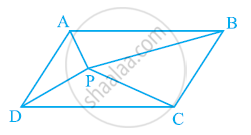
In the following figure, ABCD is parallelogram and BC is produced to a point Q such that AD = CQ. If AQ intersect DC at P, show that
ar (BPC) = ar (DPQ).
[Hint: Join AC.]
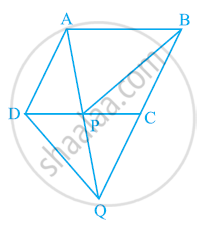
ABCD is a parallelogram, G is the point on AB such that AG = 2 GB, E is a point of DC
such that CE = 2DE and F is the point of BC such that BF = 2FC. Prove that:
(1) ar ( ADEG) = ar (GBCD)
(2) ar (ΔEGB) = `1/6` ar (ABCD)
(3) ar (ΔEFC) = `1/2` ar (ΔEBF)
(4) ar (ΔEBG) = ar (ΔEFC)
(5)ΔFind what portion of the area of parallelogram is the area of EFG.
Two parallelograms are on equal bases and between the same parallels. The ratio of their areas is ______.
In the following figure, PSDA is a parallelogram. Points Q and R are taken on PS such that PQ = QR = RS and PA || QB || RC. Prove that ar (PQE) = ar (CFD).

ABCD is a parallelogram in which BC is produced to E such that CE = BC (Figure). AE intersects CD at F. If ar (DFB) = 3 cm2, find the area of the parallelogram ABCD.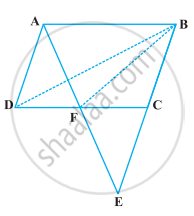
In the following figure, ABCD and AEFD are two parallelograms. Prove that ar (PEA) = ar (QFD). [Hint: Join PD].

